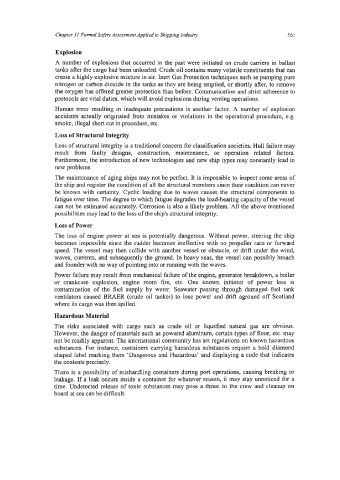Page 585 - Marine Structural Design
P. 585
Chapter 31 Formal Safity Assessment Applied to Shipping Industy 561
Explosion
A number of explosions that occurred in the past were initiated on crude carriers in ballast
tanks after the cargo had been unloaded. Crude oil contains many volatile constituents that can
create a highly explosive mixture in air. Inert Gas Protection techniques such as pumping pure
nitrogen or carbon dioxide in the tanks as they are being emptied, or shortly after, to remove
the oxygen has offered greater protection than before. Communication and strict adherence to
protocols are vital duties, which will avoid explosions during venting operations.
Human error resulting in inadequate precautions is another factor. A number of explosion
accidents actually originated from mistakes or violations in the operational procedure, e.g.
smoke, illegal short cut in procedure, etc.
Loss of Structural Integrity
Loss of structural integrity is a traditional concern for classification societies. Hull failure may
result from faulty designs, construction, maintenance, or operation related factors.
Furthermore, the introduction of new technologies and new ship types may constantly lead to
new problems.
The maintenance of aging ships may not be perfect. It is impossible to inspect some areas of
the ship and register the condition of all the structural members since their condition can never
be known with certainty. Cyclic loading due to waves causes the structural components to
fatigue over time. The degree to which fatigue degrades the load-bearing capacity of the vessel
can not be estimated accurately. Corrosion is also a likely problem. All the above mentioned
possibilities may lead to the loss of the ship’s structural integrity.
Loss of Power
The loss of engine power at sea is potentially dangerous. Without power, steering the ship
becomes impossible since the rudder becomes ineffective with no propeller race or forward
speed. The vessel may then collide with another vessel or obstacle, or drift under the wind,
waves, currents, and subsequently the ground. In heavy seas, the vessel can possibly broach
and founder with no way of pointing into or running with the waves.
Power failure may result from mechanical failure of the engine, generator breakdown, a boiler
or crankcase explosion, engine room fire, etc. One known initiator of power loss is
contamination of the fuel supply by water. Seawater passing through damaged fuel tank
ventilators caused BRAER (crude oil tanker) to lose power and drift aground off Scotland
where its cargo was then spilled.
Hazardous Material
The risks associated with cargo such as crude oil or liquefied natural gas are obvious.
However, the danger of materials such as powered aluminum, certain types of flour, etc. may
not be readily apparent. The international community has set regulations on known hazardous
substances. For instance, containers carrying hazardous substances require a bold diamond
shaped label marking them ‘Dangerous and Hazardous’ and displaying a code that indicates
the contents precisely.
There is a possibility of mishandling containers during port operations, causing breaking or
leakage. If a leak occurs inside a container for whatever reason, it may stay unnoticed for a
time. Undetected release of toxic substances may pose a threat to the crew and cleanup on
board at sea can be difficult.

